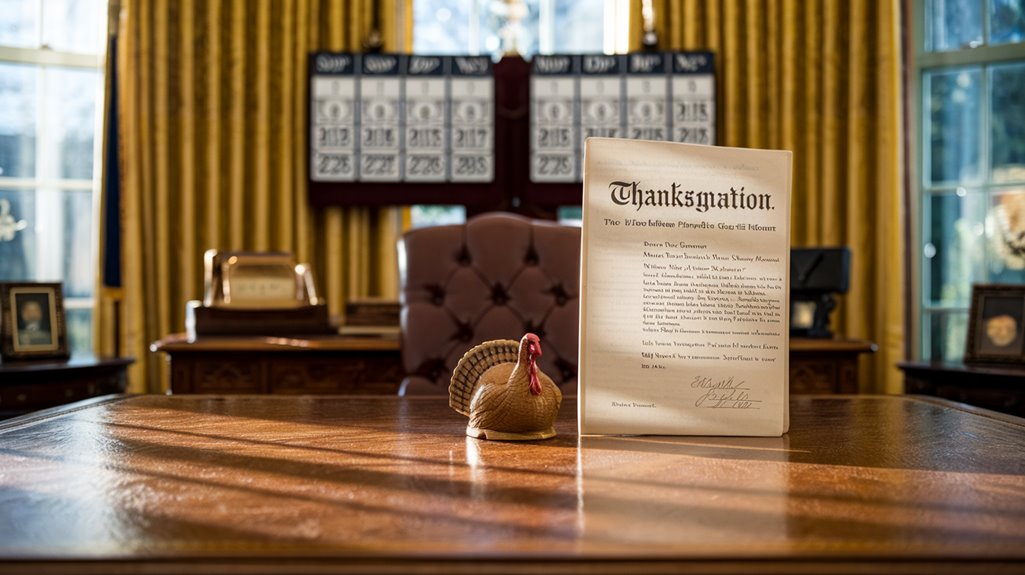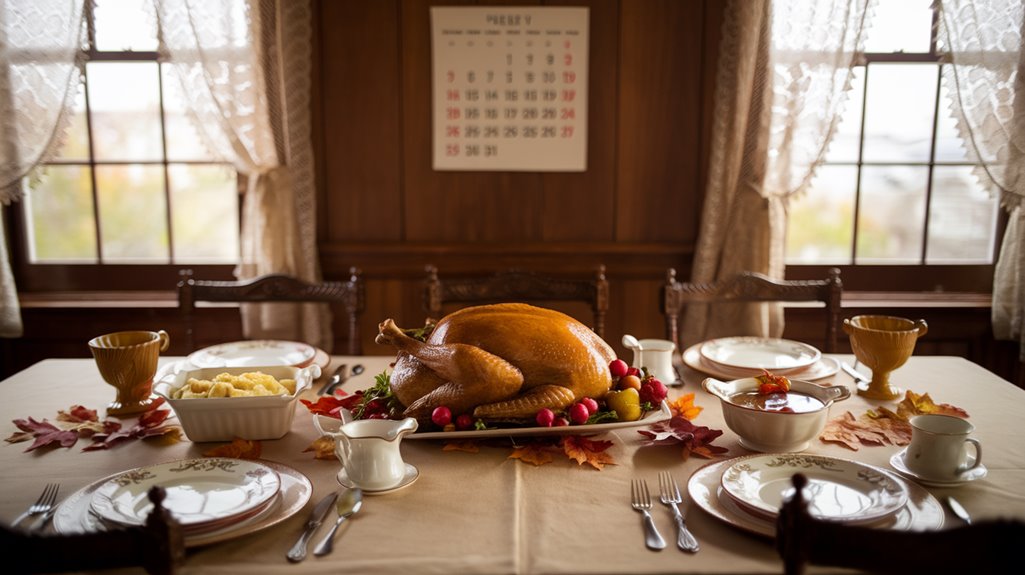FDR Moved Thanksgiving Up a Week in 1939
You might not realize that a simple date on the calendar once divided the entire United States into two distinct Thanksgiving camps. In 1939, FDR's decision to move the holiday up by one week sparked a nationwide controversy that pitted state against state, neighbor against neighbor. While the President's intention was to boost retail sales during the Great Depression, his holiday shift created such chaos that Congress had to step in to restore order. The story of "Franksgiving" reveals how even the most beloved American traditions aren't immune to political tampering.
The Great Depression's Impact on Holiday Shopping

While the Great Depression affected nearly every aspect of American life, its impact on holiday shopping habits was particularly profound. You'd have witnessed a dramatic shift towards consumer frugality as families learned to stretch their dollars further than ever before.
Much like the shift since 2008, these changes in shopping behavior proved to be lasting rather than temporary.
Retailers had to adapt quickly as shoppers abandoned mid-tier products in favor of cheaper alternatives and discount stores. Many families found comfort in home-cooked meals instead of dining out during holiday celebrations.
Holiday budgeting became more than just a good practice – it was essential for survival. You'd have seen how these newly formed shopping habits didn't disappear when the economy improved.
The Depression's influence on consumer behavior lasted long after the economic crisis ended, creating a generation that approached holiday spending with careful consideration and an eye for bargains.
These changes transformed the retail landscape and shaped how Americans would approach holiday shopping for decades to come.
FDR's Bold Decision to Change Tradition
When President Franklin D. Roosevelt made the controversial decision to move Thanksgiving in 1939, he created a significant moment in Thanksgiving history.
FDR's influence on the holiday calendar stemmed from retailers' concerns about a shortened Christmas shopping season, as the last Thursday fell on November 30 that year. The move was specifically made at the request of big retail stores. The president faced intense criticism, with some opponents comparing his decision-making to Hitler's actions.
The change sparked immediate division across America:
- 23 states followed FDR's new date, while 22 kept the traditional one
- Three states – Colorado, Mississippi, and Texas – celebrated both dates
- The split created chaos for holiday planning and business operations
The experiment, nicknamed "Franksgiving," ultimately failed to boost retail sales as intended.
Public Backlash and State Resistance
Despite FDR's economic rationale for moving Thanksgiving, the American public fiercely opposed his decision. A Gallup poll revealed that 62% of Americans disapproved of the change, and thousands wrote letters protesting the move. The disruption even angered football teams, as college coaches nationwide had to scramble to adjust their game schedules.
Public sentiment was so strong that some governors openly defied the Presidential Proclamation. Republican critics like Alf Landon accused FDR of making an impulsive, dictatorial decision.
The nation found itself divided over holiday traditions, with 23 states celebrating on November 23rd and 22 states keeping November 30th. You might be surprised to learn that three states—Colorado, Mississippi, and Texas—even celebrated both dates.
This split created chaos for families living across state lines who couldn't celebrate together. The backlash was so intense that Congress ultimately stepped in, passing a law in 1941 that permanently set Thanksgiving on the fourth Thursday of November.
"Franksgiving": A Nation Divided
As frustration mounted over FDR's Thanksgiving date change, critics mockingly dubbed the holiday "Franksgiving," highlighting the nationwide divide it created.
You'd find states, communities, and even families split over when to celebrate this cherished tradition, with its deep cultural significance hanging in the balance.
The economic implications of this change created stark divisions across the country:
- Large retailers embraced the earlier date, hoping for extended holiday shopping
- Small businesses opposed it, fearing financial losses
- Calendar manufacturers suffered significant setbacks due to outdated products
You'd see the partisan nature of the divide clearly, as Republican governors defied FDR's proclamation while Democratic states complied. A Gallup poll showed 62% of Americans disapproved of the date change, reflecting widespread public resistance.
This led to a peculiar situation where some areas celebrated on both dates, effectively creating two Thanksgivings and disrupting everything from school schedules to football games. The controversy finally ended when Congress passed legislation in December 1941 to officially establish Thanksgiving as the fourth Thursday in November.
The Path to Congressional Resolution

After two years of nationwide confusion and discord, the push for a permanent solution to the Thanksgiving date controversy gained momentum in Congress.
You'd find it interesting that despite FDR's efforts to boost retail sales with the Thanksgiving change, the economic implications hadn't met expectations, and public frustration was mounting.
The conflict was particularly evident as sixteen states refused to follow Roosevelt's proclamation.
On December 26, 1941, Congress took decisive action by passing legislation that established Thanksgiving on the fourth Thursday of November.
When FDR signed this bill into law, it finally brought an end to the contentious "Franksgiving" period.
You'll appreciate that this compromise balanced both traditional values and business interests, ensuring that states would no longer celebrate the holiday on different dates.
The resolution put an end to the yearly uncertainty and restored unity to this cherished American tradition.
Historical Lessons From a Holiday Change
The turbulent "Franksgiving" episode of 1939-1941 offers valuable lessons about the delicate balance between economic interests and cherished traditions.
When FDR altered Thanksgiving's date for economic motivations, you can see how even well-intentioned changes can backfire when they disrupt deep-rooted cultural practices.
 23 states celebrated on different days, creating scheduling complications across the nation.
23 states celebrated on different days, creating scheduling complications across the nation.
Before FDR's intervention, many retailers followed the tradition of delaying Christmas advertising and sales until after Thanksgiving had passed.










